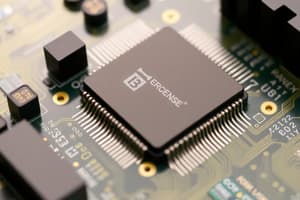Podcast
Questions and Answers
What is the main difference between Harvard architecture and Princeton architecture?
What is the main difference between Harvard architecture and Princeton architecture?
- Harvard architecture uses separate buses to access code and data simultaneously, while Princeton architecture uses a single bus for both code and data.
- In Harvard architecture, one memory contains only the program code and the other memory contains only the data, while in Princeton architecture, both program code and data share the same memory. (correct)
- In Harvard architecture, program code and data share the same memory, while in Princeton architecture, separate memories are used for program code and data.
- Harvard architecture uses a single clock cycle to access both program code and data, while Princeton architecture requires separate clock cycles for program code and data.
Why is a single clock cycle sufficient in Harvard architecture?
Why is a single clock cycle sufficient in Harvard architecture?
- Because it uses a more efficient memory management system than Princeton architecture.
- Because it eliminates the need to switch between program code and data in the same memory.
- Because it has a faster clock speed compared to Princeton architecture.
- Because it uses separate buses to access code and data simultaneously. (correct)
What components are typically integrated within a microcontroller unit (MCU)?
What components are typically integrated within a microcontroller unit (MCU)?
- Kernel, Shell, File System, Device Drivers
- Program Counter, Instruction Register, Arithmetic Logic Unit (ALU), Control Unit
- Central Processing Unit (CPU), Random Access Memory (RAM), Read-Only Memory (ROM), Input/Output (I/O) ports
- Processor, RAM, flash memory, serial receivers and transmitters (correct)
How does Harvard architecture handle memory access for program code and data?
How does Harvard architecture handle memory access for program code and data?
What is the primary purpose of a microcontroller unit (MCU) in an embedded system?
What is the primary purpose of a microcontroller unit (MCU) in an embedded system?
Why does Harvard architecture use separate program and data memories?
Why does Harvard architecture use separate program and data memories?
In which type of memory does Harvard architecture store only the program code?
In which type of memory does Harvard architecture store only the program code?
FPGAs are well-suited for applications that require real-time signal processing and data manipulation, making them well-suited for applications that require real-time signal processing. Common hardware architectures used in embedded systems: Application-Specific Integrated Circuits (ASICs): ASICs are custom-designed chips that are specifically tailored for a particular application.
FPGAs are well-suited for applications that require real-time signal processing and data manipulation, making them well-suited for applications that require real-time signal processing. Common hardware architectures used in embedded systems: Application-Specific Integrated Circuits (ASICs): ASICs are custom-designed chips that are specifically tailored for a particular application.
FPGAs offer high performance, low power consumption, and can be optimized for specific tasks. They provide flexibility in design and can be re-programmed after production, unlike ASICs which have a fixed configuration after production. 13 Common hardware architectures used in embedded systems: System in Package (SiP): SiP refers to the integration of multiple chips and components into a single package.
FPGAs offer high performance, low power consumption, and can be optimized for specific tasks. They provide flexibility in design and can be re-programmed after production, unlike ASICs which have a fixed configuration after production. 13 Common hardware architectures used in embedded systems: System in Package (SiP): SiP refers to the integration of multiple chips and components into a single package.
The choice of hardware architecture depends on factors such as the application requirements, performance needs, power constraints, cost considerations, and development resources available. Designers evaluate these factors to select the most appropriate hardware architecture that meets the specific needs of the embedded system. 15 The ARM Cortex-M0+..
The choice of hardware architecture depends on factors such as the application requirements, performance needs, power constraints, cost considerations, and development resources available. Designers evaluate these factors to select the most appropriate hardware architecture that meets the specific needs of the embedded system. 15 The ARM Cortex-M0+..
The ATmega32 microcontroller has 24 General-Purpose Input/Output pins divided into four ports.
The ATmega32 microcontroller has 24 General-Purpose Input/Output pins divided into four ports.
The ATmega32 supports UART for full-duplex asynchronous communication, SPI for synchronous communication, and I2C for three-wire serial communication with compatible devices.
The ATmega32 supports UART for full-duplex asynchronous communication, SPI for synchronous communication, and I2C for three-wire serial communication with compatible devices.
The ATmega32 microcontroller does not offer any power-saving modes to optimize energy consumption.
The ATmega32 microcontroller does not offer any power-saving modes to optimize energy consumption.
Match the following hardware architecture with its description:
Match the following hardware architecture with its description:
Match the following factors with their impact on the choice of hardware architecture:
Match the following factors with their impact on the choice of hardware architecture:
Match the following microcontroller features with their descriptions:
Match the following microcontroller features with their descriptions:
Flashcards are hidden until you start studying




